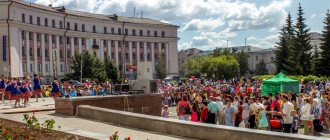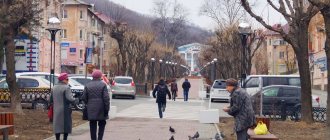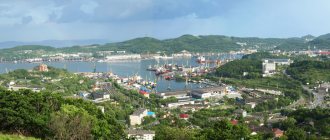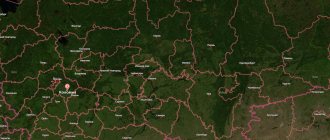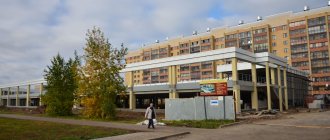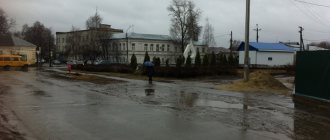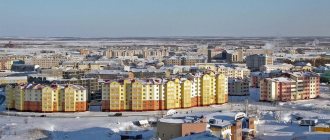The city of Kovrov will quickly help you find a map of Kovrov from a satellite. This city is located on the banks of the Klyazma River. It belongs to the territory of the Vladimir region. The city received its name from the surnames of the Kovrov princes in the 16th century, who owned it. When going on a trip around the city, it is worth using a map of Kovrov with streets in good quality. The map will help you find the object you are interested in very quickly and will save a lot of free time. Kovrov is a small but very beautiful city with magnificent natural scenery.
Where is the city of Kovrov?
Kovrov is the administrative center of the Kovrovsky district of the Vladimir region.
It is a city of regional subordination, within the boundaries of which the Kovrov urban district is formed. It is located on the left and right banks of the Klyazma River, which is a tributary of the Oka River. The approximate population is 137 thousand people, the territory area is 57 square kilometers. The climate in Kovrov is temperate continental with cold winters and warm but short summers. The annual precipitation rate is 569 mm.
Kovrov is located in the same time zone as Moscow, the offset relative to Coordinated Universal Time (UTC) is +3.
Map of Kovrov with streets
There are no districts in this city at all, but the map of Kovrov by district is still useful, since it displays a detailed layout of the city.
Geographically, it is divided into avenues and streets. Throughout the entire territory of the Kovrovsky district there are several rural-type settlements.
Unofficially, the city is divided into microdistricts with corresponding bus and trolleybus routes. For example, district six covers its route with a bus with the same number.
Also, among the people, the territory was divided into 2 microdistricts: northern and southern. The Kovrov map scheme will allow you to move around the city without any problems.
Each microdistrict has its own educational institutions, hospitals and various shopping facilities.
An important railway line passes through the city. Trains going to Siberia or the Urals pass by.
High-speed electric trains also run along this line. Just recently, a new train station was built, which can accommodate more than 900 people at a time. Using Kovrov's routes you can find important roads on the map. This is the exit to the leading road Moscow - Kazan, Kovrov - Ivanovo. Inside the city there are 2 bridges across the Klyazma: railway and for motorists. You can get around the city using buses and trolleybuses.
What is the city of Kovrov known for?
- In the old part of Kovrov there is the Transfiguration Cathedral, which stands on the top of a hill going down to the river. The cathedral was built at the end of the 19th century with the money of parishioners. Since 1934 it has been used as a prison. In 1991, a large-scale reconstruction took place.
- There is a hare museum on Griboyedov Street. More than 1,000 exhibits made of glass, metal, porcelain and other materials are collected here. The museum was founded in 1999.
- On the territory of the city there is a Square named after A.S. Pushkin. Previously, the square was a cemetery. The son of Prince V.A. Kovr is buried here. Today, there is a monument to A.S. Pushkin in the park, and the graves have been put in order thanks to the local administration.
- In 1954, a monument to V. A. Degtyarev was opened in the city. The monument is dedicated to the scientist-designer who was involved in the creation of Soviet weapons. The monument is installed on a pedestal; Degtyarev holds a weapon blank and a caliper in his hands. The authors of the monument are M. G. Manizer, A. P. Velikanov.
- On Griboyedov Street there is a monument to military builders. The monument is made in the form of an obelisk and is dedicated to the work of people who helped the development of the city. The monument was erected in 2021.
- Among the architectural monuments of Kovrov, it is necessary to highlight the Fire Tower, built in 1904. The history of the local fire brigade of 40 people begins in this building. Residents of the city call the tower a “fire castle.”
Map of Kovrov with houses
Kovrov is more than several hundred years old, but there are not enough attractions in this city. It belongs to the famous “Golden Ring”. A map of Kovrov with house numbers will help you find any interesting object.
We especially recommend visiting the following sites:
- On Victory Square there is a monument dedicated to the 200th anniversary of the city.
- There is an abundance of churches in the city, but the most majestic is the Nativity Cathedral. Its history begins in 1160, but then it was still a small wooden church. A map of Kovrov with streets and houses will help you find this cathedral.
- The churches of St. John the Warrior, Znamenskaya and Trinity also operate in the city territory.
- It is worth visiting the Znamensky Convent.
- One of the interesting attractions is the Dyagterev Museum. It represents the home of this great gunsmith. The museum preserves his office and workshop in their original form.
- On the map of Kovrov with streets you can see the historical and memorial museum.
- If you are walking around the city with children, be sure to stop by the hare museum. This is an interesting place that contains a wide variety of images of hares. There are many of these animals in the vicinity of the city. The hare is also depicted on the city coat of arms.
- One of the notable places in the city is Pushkin Park. It is small, but very beautiful and cozy. Yandex maps of Kovrov will help you create the best route.
- History buffs are recommended to visit the Klyazmensky town, where there is a ruined fortification from the 12th century and the Intercession Church of the 19th century, made in the old Russian style.
The city also offers a variety of cafes, restaurants and snack bars to suit every taste.
Mass media
Five newspapers are published in Kovrov. The most popular publication can be called “Carpet News”. The newspaper has a circulation of 19 thousand copies. It also has its own portal. Here city residents can find out the latest news, study advertisements for real estate sales, vacancies, etc.
The following periodicals are also published in Kovrov: “Znamya Truda”, “Kovrovskaya Week”, “Echo of the Week”, “Degtyarevets”. There are also 12 radio stations broadcasting in the city. However, Kovrov does not have its own station.
There are 7 analogue TV channels broadcasting in the village. Every city resident has the opportunity to install digital or cable television. In 2014, the city began broadcasting its own channel “Our Region 33”. This is the first channel in the region with its own programming. The advantage is that the broadcast goes on around the clock. Here you can find out all the news from Kovrov. The public can watch programs without connecting to cable television.
“Our Region 33” is a channel that creates interesting programs in various formats. This includes news, programs for children, and entertainment shows. You can hear a lot of good reviews about the program “It’s not evening yet.” Guests include politicians, creative intellectuals, city emergency workers and other interesting residents of Kovrov.
Population
How the number of people living in the city changed can be traced through the history of Kovrov. A rapid influx of people here has been observed since the construction of the railway began. In 1856 there were more than 2,000 people here, and within 100 years this figure had grown to impressive proportions. In 1959, the official population was already more than 98 thousand.
The largest population here was observed in the early 90s. At that time, more than 162 thousand people lived here. Then, due to the emergency and economic crisis, Kovrov’s birth rate decreased significantly. The population began to decline. According to the latest data, only 138 thousand people live here. Today the city ranks 128th in terms of population in Russia.
How to get to Kovrov
Trains passing through Kovrov depart from Kursky, Yaroslavsky and Kazansky stations. Travel time is about 4 hours. You can get to Vladimir by train from Kursky Station (direct, or via Petushki) and transfer to the train to Kovrov.
From the Moscow bus station (m. Shchelkovskaya) 7 buses depart daily to Kovrov (the first one at 9:10, the last one at 22:45). Travel time is 4.5 hours.
Driving by car from Moscow along the M7 highway (Gorkovskoye Highway), at km 243, in the village of Seninskie Dvoriki, you need to turn left at the traffic police post, from where it is 15 km to the city.
City `s history
Located on the high, right bank of the Klyazma River. Historical and statistical description of the city of Kovrov (Vladimir province) with the district. Compiled by I.F. Tokmakov (1903) The city of Kovrov has been known from Russian Chronicles since 1506. On the site of the current city was the village of Epifanovka , founded, according to legend, by some trapper Epifan in the 12th century (around 1187). Subsequently, the village was renamed the village of Rozhdestvennoye , and in the 16th century (around 1506) it belonged to the Kovrov princes, from whom it received its current name. Princes Kovrovs - from the genealogical book published according to the most accurate lists, part 2, Moscow, 1787, pp. 300, 327, 413, it is clear that the princes Kovrovs descended from the Starodub princes, their genealogy in the painting of the Gagarins, under No. 19, is also confirmed p. 238 Russian genealogy book, published by Prince. P. Dolgorukov, part 1, St. Petersburg, 1854, which says that Prince Vasily Andreevich Kovrov, the son of Andrei Fedorovich Starodubsky, Prince Ivan Vsevolodovich Starodubsky was the appanage prince of Starodub-Vladimirsky, (and not Starodub-Seversky, as some mistakenly believe). Starodub on the Klyazma River, 12 versts from Kovrov, now this area is included in the Kovrov district and is called the Klyazemsky town. In the first half of the 17th century, the village was the patrimony of the Suzdal Spaso-Evfimievsky Monastery, which was donated by Prince Ivan Kovrov (according to the monastery documents). With the establishment of monastic states in 1764, Kovrovo was made an economic village, and in 1778 it was renamed a district town; in 1796, the city was left behind the state (a provincial town), but in 1803 it was restored again. In the city, with the most thorough archaeological investigations, it is impossible to find anything inherited from antiquity in favor of history, except for five gravestones of white stone in the general cemetery at the church of the Holy Great Martyr John the Warrior, among a separate fence (after the revolution it was destroyed by the forces of militant atheists, encouraged by the authorities) . The following inscriptions were carved on them:
- Summer 7049 (1541) - the servant of God, Prince Andrei Vasilyevich Kovrov, died on Voroncha.
- His son (his years are not visible, but half a stone) Vasilyevich Kovrov has passed away.
- On the 13th day of the summer of 7059 (1551) in the month of November, in memory of John Chrysostom, the servant of God Fyodor Nikitin, Prince, reposed.
- 7049 (1541) Prince Dimitri died (then the words were erased)
- In the summer of 7070 (1532), in memory of our reverend father... the servant of God, Prince Vasily Ivanovich Kovrov, reposed.
These passages turn us to history, according to which the name of the princes Kovrov or Kovrovs appears for the first time in 1505, in the person of Vasily Andreevich, who, under Grand Duke John, was the 3rd first Russian governor in the newly acquired glorious Biarmia or great Perm. His sons: Andrei, Ivan and Semyon Vasilyevich, of whom the first, who died in Voronach, near the city of Polotsk region, which was 100 versts from Pskov, was probably there under the governor of Pskov, Prince Peter Ryapolovsky (whose fatherland the village of Ryapolovo is still located in Kovrov district ), sent by Emperor Vasily Ioanovich in 1523 with the children of boyars and Tatars during the era of the destruction of the Order of German knights and the annexation of Smolensk to Russia. In 1536, these brothers divided their family estate, from which Prince Semyon Vasilyevich received the village of Rozhdestvenskoye and Kovrovo. In 1566, on July 2, as can be seen from the sentencing letter, there was Prince Osip Andreevich Kovrov. This village of Kovrovo in 1567 by the son of Prince Semyon, John under Archimandrite Savvatia was attached to the Suzdal Spaso-Evfimevsky Monastery in 1578 by the widow after Prince Vasily Ivanovich, nee Maria Mezetskaya (Princess Maria Semenovna Mezetskaya (Meshchovsky) daughter of Prince Semyon Mikhailovich, a participant in the campaigns to the prince Vasily's marriage 3, was married to Prince Vasily Ivanovich Kovrov. Attached to the same monastery: Seltso Andreevskoe; Villages: Suvorikha, Sassanova, Ugryumov, Frolovo with wastelands, forest, fishing and beaver fishing. For this grandson of Prince Andrei Vasilyevich in 1547, the prince Nikita, the son of Prince Ivan Andreevich, villages and wastelands were annexed to the Spaso-Evfimievsky Monastery under Archimandrite Job: Sadishchi; Kavrizino; Ivanino; Shchedrino: Vatino; and in 1577, Prince Nikita’s cousin, Prince Ivan, son of Joseph Andreevich, annexed the village of Shishovka and the village of Zurneva with wastelands. In 1568-1569 there was Prince Yuri Vasilyevich Kovrov. In the 17th century, there was a customs in the village of Kovrov, despite the fact that trading was carried out once a year, on Christmas Day, when merchants from different cities gathered with all sorts of goods . In 1657, it was ordered to establish a permanent market in Kovrov, because various people from Kazan and Kazan cities walked through the city.
Temples of Kovrov
Nativity of Christ Cathedral Address: st. Pershutova, 15,
Nativity of Christ Cathedral
It is unknown when and by whom it was built, the building is made of stone, the bell tower and fence are also made of stone. Thrones: the main one in honor of the Nativity of Christ (celebration on December 25), the Southern chapel in honor of the Smolensk Icon of the Mother of God (celebration on July 28 and October 12), the North in the name of St. Macarius, Abbot of Kalyazin (celebration on March 17).
Spaso-Preobrazhensky Cathedral Address: st. Pershutova, 28
Altars: the main one of the Transfiguration of the Lord (celebration on August 6), side altars: southern - in the name of St. Nicholas the Wonderworker (celebration on May 9 and December 6), northern - in honor of the icon of the Mother of God, called “Joy of All Who Sorrow” (celebration on October 24. In the cathedral there is an icon of the Exaltation of the Honest and Life-Giving Cross of the Lord, in which there is a small silver-gilded cross with particles of the relics of the Holy Great Martyrs Barbara and Anastasia the Pattern-Writer, the Martyr Natalia, the Great Martyrs: Fyodor Tirov and John of Belgrade and the Venerable Avramius of Galich; this cross is attached to the cathedral in 1884 by the nobles Kultashov. Architect: Nikolai Andreevich Artleben.
Cemetery Church in the name of the Holy Great Martyr John War Address: st. Pershutova, 7 Architects: Petrov E.Ya., A.N. Vershinsky.
Built in 1827 by the zeal of the titular councilor Oshanin Pyotr Borisovich and the Kovrov tradesman Ivan Fedorovich Pilgrimov. Thrones: the main one - in the name of the Holy Great Martyr John the Warrior (celebration on July 30), the side altar - in the name of the Holy Great Martyr George the Victorious (celebration on April 23). On the territory of the cemetery next to the church there was a necropolis of the Kovrov princes. In 1900, the administration and workers of the Treumov weaving and spinning factory initiated a petition to the Holy Synod to establish an independent parish at the cemetery church in the name of the Holy Great Martyr John Voin. Base. The fact is that, like most Russian cities, Kovrov expanded from year to year, and the parish has one cathedral with two churches, but with one clergy. There is no doubt that it is difficult for one clergy to fulfill the requirements with such a large population, and therefore there were frequent misunderstandings and displeasure about the slowness of the cathedrals in baptizing infants, admonishing the dying, and even in seeing off the deceased to their place of eternal rest. The cemetery clergyman does not have the right to fulfill any requirements: he does not have metric books, since the church in the name of the Holy Great Martyr John War is assigned to the cathedral. The workers of the Treumov factory, and their number, without their families, was up to 2000, always visited the temple, and with requests they must certainly address the cathedral. This is the reason why they wanted the Church of the Holy Great Martyr John the War to become a parish church for them, and in this sense they filed a petition with Bishop Sergius. On August 5, 1923, the Ioanno-Voinovskaya religious community was registered, which, uniting “citizens of the Orthodox confession to satisfy their religious needs,” tried to somehow prevent the closure of the church. In 1929, the temple belonged to the “autocephalist” community. On the site of the city cemetery, a park was laid out, named after A.S. Pushkin.
Pushkin Park, on the site of the old city cemetery
entrance to the park
The inscription “The hero of Socialist Labor, Doctor of Technical Sciences, Major General of the Artillery Service Vasily Aleseevich Degtyarev is buried here.”
Temple in honor of the Feodorovskaya Icon of the Mother of God (at a mechanical establishment Address: Bortsov Street 1905. Intersection of Bortsov 1905 and Lopatina Streets. Architect: N.A. Artleben. Feodorovskaya Church was built in 1875 with the care of craftsmen and employees at a mechanical establishment workshops of the Main Society of Russian Railways, consecrated on May 25, 1875. By order of church warden Dmitrieev, a huge banner-picture depicting the Resurrection of Christ was erected.Before the start of Easter Matins, the kerosene lamps of the picture were lit, but no person was left to observe their combustion was. During Matins, one of these lamps is believed to have fallen and kerosene splashed onto the wooden frame of the picture. It flared up and the flames at one moment engulfed the entire huge transparent image soaked in oily substances. One of the worshipers, who came out at that time to the porch , shouted: “Fire!" and there was turmoil in the church. The people rushed to the exit in panic, but when they saw a huge flame above them, they stopped in horror. At this time, thanks to the foresight of some, the iron doors of the church were closed, and the fire was extinguished by the means at hand. This incident caused a murmur on the part of the artisans against the church warden, whose indiscretion disrupted the solemn course of the Easter service. Throne in honor of the Feodorovskaya Icon of the Mother of God (celebration on March 14 and August 16).
Calico weaving factory of Treumov Ivan Andreevich.
weaving factory
Treumov I.A. - founder of the factory
Wonderful people. Degtyarev Vasily Alekseevich - Soviet gunsmith. Tikhonravov Konstantin Nikitich, famous archaeologist and historian of the Vladimir-Suzdal region, editor of the Vladshupr Provincial Gazette, was born in the mountains. Kovrov on April 28, 1822, died in Vladimir on July 6, 1879. Treumov Ivan Andreevich, born on August 18, 1849 in the village of Malyshevo, Kovrov district, Vladimir province, died on December 29, 1899. Treumov was considered one of the most honorable citizens of the city of Kovrov and was the mayor. Ivan Andreevich died after a long mental illness. A particularly fatal influence on Treumov’s illness was the murder he committed by accident on May 1, 1895, when he shot and killed the Kovrovsky zemstvo chief, Dmitry Petrovich Mankov, his closest friend and comrade, while hunting. This tragic incident had sad consequences for Treumov: a man of iron will, tireless energy and hard work, he became insane in a very short time and, almost without regaining consciousness, lived out only the most miserable life. Meanwhile, I.A. Treumov until this time was the most prominent figure in the city of Kovrov, he built two large factories and, in addition, most recently he was the mayor of the city, established an exemplary maternity hospital at the zemstvo hospital, built a church at the prison and founded a large two-class school in the suburban village of Malyshevo. Almost the entire city was present at the funeral on December 31, 1899; many wreaths were laid on the coffin of the deceased.
Kovrov, Vladimir region
Location and travel
Geographic coordinates: Latitude 56°21′49″N (56.363628), Longitude 41°18′40″E (41.31122). Travel from Moscow: By train - 3 hours, High-speed electric train "Lastochka" - 2 hours. 22 min. BlaBlaCar - 4 hours, by bus from the bus station on Shchelkovskaya - 5 hours. Travel from St. Petersburg: By train - 14 hours, BlaBlaCar - 13 hours 10 minutes. Distance from Moscow - 271 km, from St. Petersburg - 976 km.
Industry and economics
Kovrov is a major industrial center. What is the price of the Degtyarev plant! Here they manufacture high-quality small arms and missile weapons, motorcycles, mopeds, sewing machines, etc. Today, the entire industry of Kovrov rests on this company. Construction of the plant began in 1916. Initially it was a rifle and machine gun factory, the main defense institution of the city. Nowadays, special equipment for the food industry is also manufactured here.
The Kovrov Mechanical Plant can also be called the pride of the city. Small arms, glass cutting equipment, solar panels, and equipment for nuclear power plants are also manufactured here.
The Kovrov Electromechanical Plant produces hydraulic drive equipment, as well as defense robotics. The excavator plant produces high-quality agricultural equipment. In 2011, a monument to the excavator was erected in the city. The enterprises described occupy more than 70% of the city's total industry. About 50% of Kovrov’s working-age population is employed here.
The light industry sector is also thriving here. LLC produces consumer goods from plastic. These are garden goods, snow shovels, children's plastic skis, etc. A lot of good reviews can be heard about the Sudar clothing factory, which specializes in the production of men's suits.
Sports achivments
In the city of Kovrov, Vladimir region, motorcycle sports are well developed. At the same time, the training of young racers begins at a young age. Many boys dream of learning to drive a two-wheeler. Of great interest is motorball, a rare sport in which football is played on motorcycles. In addition, the city has special markings for motocross racing.
There is a football club in Kovrov. The city's population follows the achievements of local football players. The Kovrovets club was founded back in 1923. During the Soviet era, he took part in many championships among masters and took prizes. In 1995, the club managed to win the championship in the Golden Ring interregional championship. Now “Kovrovets” takes an active part in regional competitions. And some students went up the career ladder and got into federal football teams.
In Kovrov, great attention is paid to children's sports. From the age of 5, children can enroll in a sports dance club. From the age of 7-8 you can start going to athletics, fencing, Greco-Roman wrestling, gymnastics, etc.
Extreme sports are also developing in Kovrov. So, in 2014, a winch for wakeboarding was installed on a local river.
Museums
The Kovrov Historical and Memorial Museum is located in the former building of the Zemstvo Government, built in 1889 (Abelmana St., 20). Opening hours from 10:00 to 17:00 (on weekends - from 11:00), except Monday.
The designer lived in the house-museum of V. A. Degtyarev (6-a Degtyareva St.) since 1924. The interiors of the rooms and the workshop where he manually sawed out the parts of the guns were recreated in the house; all the items are original.
The hare museum is located in the city library for family reading (Griboedova St., 117). The impetus for its creation was the hares depicted on the city’s coat of arms. More than 700 eared inhabitants “live” in the museum - the smallest is glass, about 15 mm in size, the largest is soft, the size of a three-year-old baby. The gingerbread hare, the beaded hare and, of course, the motorcyclist hare delight children. Opening hours: Monday-Thursday - from 10:00 to 19:00, Friday and Sunday - from 10:00 to 18:00, Saturday - closed.

